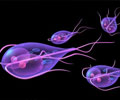
"If we can genetically modify a bacterium that could be put back into insects, it could be used as a way to combat diseases transmitted by those insects," says Adam Clayton, a University of Utah Ph.D. student in biology and a first author of a study unveiling the new bacterium and its genome or "genetic blueprint."
The study will be published Thursday, Nov. 15 in the Public Library of Science's online journal PLoS Genetics.
It "shows the origin of the mutually beneficial symbiotic relationship between bacteria and insects," says biology Ph.D. student Kelly Oakeson, the study's other first author. "There are bacteria in the environment that form symbiotic relationships with insects. This is the first time such a bacterium has been found and studied."
Colin Dale, the study's senior author and an associate professor of biology, says the findings provide "a missing link in our understanding of how beneficial insect-bacteria relationships originate. Our work shows specifically that these relationships arise independently in each insect. This is a surprising conclusion: the insect picks up a pathogen that is widespread in the environment and then domesticates it. This happens independently in each insect."
Source-Eurekalert












